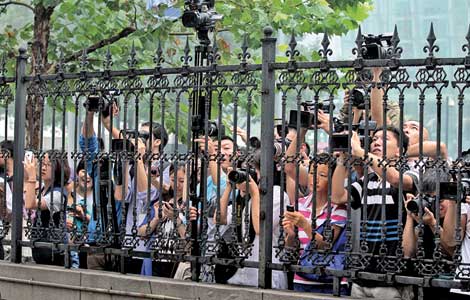Bond trial program set to expand
Updated: 2013-08-29 07:25
By Gao Changxin in Hong Kong and An Baijie in Beijing (China Daily)
|
||||||||
Move can help ease banks' risks
China will expand a trial program that allows the sale of bonds backed by bank loans, according to an executive meeting of the State Council presided over by Premier Li Keqiang on Wednesday.
The meeting gave the green light for the first time for high-quality securitized assets to trade on stock exchanges as a way to boost bank liquidity, though it did not elaborate on the timing and scale by which the trial will be expanded.
Analysts believe the move will help quench liquidity demand in China's economy, which is going through a pivotal transformation.
The transformation is guided by the framework "de-leveraging, no stimulus and structural reforms".
High-risk assets will not be included in the trial, according to a statement released after the meeting.
"Expanding the credit securitization trial is a specific measure to let the financial sector support structural reforms and economic transformation," said the statement.
"It can optimize allocation of financial resources, activate existing capital and better support development of the real economy", which refers to manufacturing and services sectors.
China started bank loan securitization in 2005, when China Development Bank issued bonds based on loans totaling 4.7 billion yuan ($765 million).
Further moves were stalled by the 2008 financial crisis, which was triggered by asset securitization.
The gate was reopened last June, when the central bank authorized a 50 billion yuan quota for the country's lenders to securitize their loans on condition of regulatory approval. The 50 billion yuan quota is about to run out.
Asset securitization is still in its infancy in China. The quota is a pittance compared with the balance of various loans from Chinese banks, estimated at around 67 trillion yuan at the end of 2012.
In a research report published in June by China Research & Intelligence, the room for China's credit assets securitization was about 300 billion yuan.
Chen Ruiming, an analyst with Haitong Securities, said that loans totaling 2 trillion yuan need to be securitized at the moment, given Chinese lenders' eagerness to shrink their loan books.
Currently, Chinese banks are eager to strengthen their financial positions, in face of pending market competition to be brought about by the central bank's further liberalization of deposit and lending rates.
The People's Bank of China scrapped the lower limit on the bank lending rates in June. But the upper limit, which is widely believed to be riskier and more conducive to competition, has yet to be loosened.
Last week, People's Bank of China Governor Zhou Xiaochuan said he is ready to do more.
"We've got the technical arrangements and other conditions in place for realizing such liberalization as soon as possible," he said in an interview with China Central Television.
Wang Peng, research head of Fortune Guide, told the Securities Times that bank loan securitization will help lower banking system risks.
"Securitization re-prices and moves the assets, and that increases bank liquidity and dissolve risks," Wang said.
China's new leadership has been trying to rein in credit growth, which has run rampant over the past few years as the economy has become less responsive to credit stimulus.
The country's total social financing, the widest measure of credit, has fallen for four consecutive months to a 21-month low in July, when society as a whole raised 808.8 billion yuan, down 23 percent year-on-year.
Lu Zhengwei, chief economist at Industrial Bank, said he expects the figure to stay at a low of around 800 billion in August.
Loan securitization offers a new source of funding in the tightening credit environment. The State Council meeting stressed that liquidity generated by securitization should go to weak links and core areas in the economy, especially the agricultural sector, small and micro businesses, shantytown renovation and infrastructure investment.
Health services
Meanwhile, China will encourage social and overseas investment in the health-service sector, as people's demands for such services have been increasing rapidly in recent years, according to the executive meeting.
Health services cover industries such as medical treatment, care for the elderly and rehabilitation training.
Officials at the meeting agreed that developing health-service industries will help improve people's livelihoods and provide more job opportunities.
The meeting called for building more service centers for the elderly in urban communities and rural areas.
Commercial health insurance products should be diversified to meet public needs, and growth in health-related industries such as pharmaceuticals, medical equipment and traditional Chinese medicine should be encouraged.
The meeting also highlighted professional training for nurses, rehabilitation workers and paramedics.
Contact the writers at gaochangxin@chinadaily.com.cn and anbaijie@chinadaily.com.cn
(China Daily USA 08/29/2013 page3)

 US vows action in Syria even without UN backing
US vows action in Syria even without UN backing
 Li Na advances to 3rd round
Li Na advances to 3rd round
 Obama, marchers mark 50 yrs since King's speech
Obama, marchers mark 50 yrs since King's speech
 Singers' son pleads not guilty
Singers' son pleads not guilty
 Rubber duck to float in Beijing
Rubber duck to float in Beijing
 New York Times, Twitter hacked by Syrian group
New York Times, Twitter hacked by Syrian group
 Five apps to help you 'breathe' in Beijing
Five apps to help you 'breathe' in Beijing
 Wozniacki survives battle with Chinese qualifier
Wozniacki survives battle with Chinese qualifier
Most Viewed
Editor's Picks

|

|

|

|

|

|
Today's Top News
China, US officials discuss defense ties
Envoy to seek release of US citizen
China leads the way on multilateral defense co-op
Bond trial program set to expand
China set to lead e-commerce market
US vows action in Syria
Firms 'must foster' jobs abroad
5-yr work plan to fight graft unveiled
US Weekly

|

|






